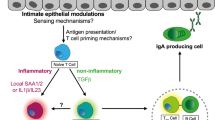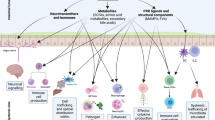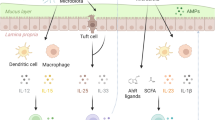Abstract
Our studies have focused on understanding the mechanisms of interactions between the indigenous intestinal flora and the mammalian host in both physiological and nonphysiological conditions. In particular, we have focused on the function of innate microbial pattern recognition by Toll-like receptors in the context of tissue injury and repair, spontaneous colitis, and postnatal development.
Similar content being viewed by others
Introduction
In humans, inflammatory bowel disease is a state of chronic inflammation of the intestine of which the pathoetiology and pathogenesis are incompletely known. Both, Crohn's disease and, to a lesser extent, ulcerative colitis, result over time from multifarious interactions between genes and the environment. The complexity of the development of Crohn's disease is reflected by the fact that the occurrence of disease may be both sporadic and hereditary and that numerous loci of susceptibility have been identified. In experimental animals, many different genetic modifications, both polygenic and monogenic, including both gene ablation and overexpression, result in the development of spontaneous intestinal inflammation.
Two concepts have emerged as being central to the patho-genesis of inflammatory bowel disease: (1) unregulated T-cell-mediated immune responses and (2) an aberrant or inappropriate relationship with the indigenous microbial flora. The observations in both humans and animal models of a T-cell-mediated and T-cell-dependent disease process, disease association with polymorphisms in genes encoding for microbial pattern recognition receptors and the dependence on the indigenous microflora for disease in many animal models of spontaneous intestinal inflammation have been central to these ideas.1, 2
Our goal over the last 6 years has been to better understand the function of the innate immune system, particularly that of the evolutionarily conserved family of pattern recognition receptors of Toll-like receptors (TLR), in the recognition of the host microbial flora. Here we summarize our finding of the functions of TLR–commensal interactions in both health and disease, and introduce our recent investigations into the study of postnatal intestinal ontogeny and our attempts to provide insight into the mechanisms and semantics of this ecologically dependent developmental process.
Complex Metazoans are Colonized with an Indigenous Microflora
Mammals are colonized with a diverse and abundant indigenous microflora. It is estimated that 500–1,000 different species of 1014 microorganisms may colonize mammals such as rodents and humans, although the number of species is most likely an underestimate.3
Commensal bacteria colonize many organs of mammals, including the gingiva, oropharynx, skin, genitourinary, and respiratory tracts. However, the greatest density, magnitude, and diversity occur in the gastrointestinal tract, particularly in the large intestine. The most abundant microorganisms in the colon are bacteria, and it is this group that has received the most attention by researchers. However, eukaryotes such as yeast may be parts of the commensal microflora. In addition to expanding our knowledge of the bacterial diversity of the mammalian intestine, the metagenomic revolution in microbial ecology has recently brought to our attention the underappreciated presence of both a viral and archaebacterial flora.4, 5
Toll-Like Receptors Recognize Conserved Molecular Products of Microorganisms
TLRs are the best studied of a class of host receptors known as pattern recognition receptors (Figure 1). Other pattern recognition receptors include membrane proteins such as scavenger receptors and C-type lectins; secreted molecules such as acute phase and complements factors; and cytosolic sensors such as nucleotide oligomerization domain proteins, NACHT, LRR, PYD-containing protein (NALPs), and neuronal apoptosis inhibitory protein (NAIPs). They also include cytosolic viral nucleic acid receptors such as retinoic-acid-inducible gene I (RIG-I), melanoma differentiation-associated gene 5 (MDA-5), and DNA-dependent activator of interferon-regulatory factors.6, 7, 8
Toll-like receptors. TLRs are involved in recognition of microbial patterns both at the plasma membrane and at intracellular compartments. Upon ligation, TLRs dimerize and transmit signals throughout the cell through adaptor molecules such as MyD88 and TRIF. IRF, interferon regulatory factor; LPS, lipopolysacchride; MAPK, mitogen-activated protein kinase; MyD88, myeloid differentiation factor 88; NF-κB, nuclear factor-κB; TIRF, TIR domain-containing adapter-inducing interferon-β; TLR, Toll-like receptors.
Pattern recognition receptors such as TLRs are best known for their ability to recognize conserved structures of microorganisms originally named as pathogen-associated molecular patterns (PAMPs) by Janeway.9 In fact, PAMPs are common to all microorganisms regardless of “pathogenicity”.
Phylogenetic analysis has revealed that in vertebrates, the TLR group is divided into at least six subfamilies10 and three larger families, which seem to correspond to the type of macromolecular ligand recognized (nucleic acid, protein, and lipid). TLRs 1, 2, 4, 6, and 10 are involved in lipid recognition, TLRs 5 and 11 recognize proteins, and TLRs 3, 7, 8, and 9 sense nucleic acids, although there are exceptions to this trend. The best-characterized microbial ligands form TLRs are lipopolysacchride (endotoxin) of gram-negative bacteria (TLR4), bacterial lipoproteins and lipotechoic acid, fungal zymosan (TLRs 1, 2, and 6), bacterial flagellin (TLR5), a profilin-like molecule from the protozoan Toxoplasma gondi (TLR11), unmethylated CpG motifs present in DNA (TLR9), double-stranded RNA (TLR3), and single-stranded RNA (TLR7, 8). A growing list of microbial products has been found to activate host cells through TLRs.
TLRs localize to different subcellular locations that seem to correspond to the chemical nature of the ligands they recognize. In general, lipid and protein recognition TLRs are at the plasma membrane, whereas nucleic acid-sensing TLRs are found in endocytic compartments. Upon ligation, TLRs form homo- and hetero-dimers, and transmit signals throughout the cell through toll/interleukin-1 receptor (TIR)–TIR homotypic interactions with one or a combination of four TIR-containing adaptor proteins, myeloid differentiation factor 88 (MyD88), TIR domain-containing adapter-inducing interferon-β (TRIF)/TIR-containing adapter molecule (TICAM)-1, TIR domain-containing adapter protein (TIRAP)/MyD88-adapter-like (MAL), and TRIF-related adaptor molecule (TRAM)/TICAM-2. All TLRs (in addition to interleukin (IL)-1, IL-18, and IL-33R), except TLR3 (which exclusively signals through TRIF), signal through a bottleneck and use MyD88 as an adaptor.11
Signaling transduction from TLR occurs through a number of physical and biochemical events of which reversible covalent modifications through phosphorylation and ubiquitination are paramount. All TLRs use IRAK and TRAF family members as upstream components. This signaling converges on intermediate-level kinases such as TAK-1 and TBK1/IKKi leading to signal diversification, and amplification and activation of MAP kinase (JNK, p38, and ERK), interferon regulatory factor (IRF) (notably IRF3, IRF5, and IRF7), and nuclear factor-κB pathways.8
TLRs have a central function in orchestrating both innate and adaptive immune responses in host defense from infection. In particular, TLRs have a critical function in the activation of naive T cells and T helper type 1 development. TLR engagement on antigen-presenting cells, such as dendritic cells and macrophages, leads to migration from the periphery to secondary lymphoid organs, upregulation of costimulatory molecules (such as B7), enhanced antigen processing and presentation, and the production T helper type 1 polarizing cytokines such as IL-12.1
How are Constitutive Inflammatory and Immune Responses to The Intestinal Microflora Avoided?
As stated above, (1) the mammalian intestine (in particular the colon) is colonized with trillions of microorganisms; (2) as microbes, these organisms contain PAMPs; and (3) recognition of these PAMPs by host-evolved pattern recognition receptors, such as TLRs, induces potent inflammatory and immune responses. Thus, the question that arises is: how are constitutive inflammatory and immune responses to the intestinal microflora avoided (Figure 2)? One mechanism by which this may occur is by a “passive” lack of recognition. In this case, the microbial flora are sequestered to the luminal aspect of the intestine, and host pattern recognition receptors are located in places that avoid constitutive ligation by microfloral PAMPs such as intracellularly or on the basolateral membrane of epithelia or on myeloid cells present at the lamina propria, below the basement membrane (Figure 2). Another mechanism of host–microbial immune homeostasis seems to be because of “active” regulation of recognition of the host microbial flora by cells such as regulatory T cells and immunoregulatory factors (IL-10 and IL-2), as the absence of these factors in animal models leads to commensal-dependent spontaneous colitis.1, 12
Models of intestinal immune homeostasis. Two nonmutually exclusive models by which the host avoids constitutive and potentially deleterious inflammatory and immune responses to the indigenous microflora. In the passive model, unresponsiveness is maintained by a lack of recognition of the microbial flora by the restriction of microbes to the intestinal lumen and compartmentalized expression of pattern recognition receptors such as TLRs to the apical aspect of epithelial cells or on myeloid cells resident at the lamina propria. In the active model, anti-inflammatory and immonoregulatory factors such as IL-10 and regulatory T cells mediate appropriate response to the intestinal flora by inhibiting innate and adaptive recognition and responses. IL, interleukin; TGFβ, tumor growth factor β; TLRs, Toll-like receptors.
Environmental and ecologic transitions in postnatal development. After birth, the intestine undergoes many changes including the maturation of the local adaptive immune system and changes in intestinal epithelial proliferation and differentiation. This occurs in the backdrop of many changes with regard to the ecologic microenvironment including changes in the microbial flora, diet, and factors provided from the mother such as immunoglobulins found in mother's milk.
Testing the Active Hypothesis: Spontaneous Colitis in the Absence of Il-10 is Dependent on TLR Signaling
Mice deficient in IL-10 develop a T-cell-dependent, T helper type 1-driven colonic inflammation consisting of massive leukocyte recruitment and epithelial hyperplasia.13 In specific pathogen-free environments, IL-10 deficient (IL-10−/−) mice develop these features in early adulthood (6–8 weeks old). However, IL-10−/− are completely free of disease when reared under germ-free conditions, demonstrating the critical function of the indigenous microflora in the etiology of disease. What aspect of the diverse and complex microflora drives the development of colitis in the absence of IL-10? Is it the plethora of foreign antigens in the noneukaryotic flora, which stimulates the adaptive immune system? Or, does the innate recognition of conserved elements of the microbial flora precipitate disease and innate immune recognition controls the adaptive immunopathology? We designed experiments to test the latter, specifically to test the hypothesis that pattern recognition of the microbial flora by TLR is critical for the development of spontaneous colitis. Mice deficient in both IL-10 and MyD88 were completely protected from colitis, and showed no gross or histopathologic evidence of disease over their entire lifespan (>2 years).14 These data demonstrate that the critical anti-inflammatory function of IL-10 in intestinal homeostasis is to regulate activation of TLR by the conserved molecular patterns of the indigenous microflora.
Testing the Passive Hypothesis: Steady-State TLR–Commensal Interactions in the Adult Colon
Proceeding from the above-discussed analysis of the function of the active regulation of TLR recognition of the microflora in mediating intestinal immune homeostasis, we pursued studies aimed at determining whether “passive” means, such as the presence of an intact epithelial barrier, were important in avoiding constitutive inflammation at the colon driven by the microflora and specifically because of sequestration preventing the engagement of basolaterally located TLR.15 In short, over the course of our studies we have found that commensal bacteria are recognized by TLRs under normal steady-state conditions and this interaction has a crucial function in the maintenance of intestinal epithelial homeostasis. Furthermore, we found that the activation of TLRs by commensal microflora is critical for the protection against gut injury and associated mortality.15 These findings have revealed a new function of TLRs, such as the control of intestinal epithelial homeostasis and protection from injury, and provide a new currency for the evolution of host–microbial interactions.
Postnatal Development of the Mammalian Intestine
Studies comparing germ-free animals with those raised under conventional or specific pathogen-free conditions have demonstrated that many aspects of “normal” host physiology and development are actually because of symbiosis between the host and the microbial flora that colonizes its tissues. The “normalcy” of physiology bestowed upon the host by the indigenous microflora ranges from the bioavailability of energy sources and vitamins to the maturation of the mucosal and systemic immune system. The mechanisms by which the indigenous microflora promotes the postnatal development of the host are unknown, although most focus has centered on the function of novel metabolic abilities of commensal bacteria such as the synthesis of polyamines and short-chain fatty acids.
There are remarkable similarities among the differences between conventionally raised and germ-free adult mice, and the changes that occur after birth as a part of the postnatal developmental “program” (Figure 3). These include both local and systemic changes. In the intestine, colonization of either the neonate or the adult germ-free mouse leads to expansion, development, and functional changes of the adaptive immune system (dendritic cells, T cells, B cells, mast cells, and eosinophils) and changes in epithelial homeostasis such as enterocyte lineage decisions and differentiation. Systemically, the most profound changes occur at organized lymphoid tissues such as Peyer's patches, mesenteric lymph nodes, and spleen.
Given the critical function of commensal–TLR interactions in both the steady-state and injury-induced state of the adult colon, we have recently embarked on a mission to determine whether innate pattern recognition has an important function in mediating other aspects of mammalian host–microbe symbiosis, within a broader context of the life history of this interaction, such as during postnatal development. Additionally, we have designed these experiments with the aim of discovering new aspects of postnatal intestinal development, comparing this process between different regions of the intestine (small intestine vs. colon) and providing molecular insights into this environmentally shaped and plastic process (by whole genome analysis).
Our initial analysis has revealed the global changes in gene expression that occur with postnatal developments such as those upregulated with weaning (Figure 4). We have identified the transcriptional profile of genes involved in carbohydrate, lipid, and amino acid metabolism in addition to genes involved in innate and adaptive immunity. Comparison of the developmental gene expression profile between TLR-proficient and TLR-deficient littermates has revealed the function of TLRs in these developmental switches (Figure 4).
Functional genomic analysis of transcripts upregulated with weaning in the small intestine. Transcripts upregulated with weaning in the small intestines of WT and MyD88−/−TRIF−/− littermates were analyzed by gene ontology for biological process. This analysis reveals that many developmental changes such as those involved in ion transport, cholesterol metabolism, and host–pathogen interactions are regulated by TLRs. TLRs, Toll-like receptors; WT, wild type
The major transitions in mammalian life that occur after birth are rife with environmental variability including changes in diet, maternal passive immunity, qualitative, and quantitative aspects of microbial colonization, and of course, the concatenate development of the host (Figure 3). Our studies hope to fill gaps in our knowledge of host–microflora interactions in host physiology, and provide both novel descriptions and mechanistic insights into this dynamic, ecologic, and environmentally regulated period.
Disclosure
Seth Rakoff-Nahoum is the co-author of one patent on the use of TLR agonists in GI injury therapy. Ruslan Medzhitov declared no financial interests.
References
Strober, W., Fuss, I. & Mannon, P. The fundamental basis of inflammatory bowel disease. J. Clin. Invest. 117, 514–521 (2007).
Podolsky, D.K. Inflammatory bowel disease. N. Engl. J. Med. 347, 417–429 (2002).
Sonnenburg, J.L., Angenent, L.T. & Gordon, J.I. Getting a grip on things: how do communities of bacterial symbionts become established in our intestine? Nat. Immunol. 5, 569–573 (2004).
Eckburg, P.B. et al. Diversity of the human intestinal microbial flora. Science 308, 1635–1638 (2005).
Zhang, T. et al. RNA viral community in human feces: prevalence of plant pathogenic viruses. PLoS Biol. 4, e3 (2005).
Medzhitov, R. Recognition of microorganisms and activation of the immune response. Nature 449, 819–826 (2007).
Meylan, E., Tschopp, J. & Karin, M. Intracellular pattern recognition receptors in the host response. Nature 442, 39–44 (2006).
Lee, M.S. & Kim, Y.J. Signaling pathways downstream of pattern-recognition receptors and their cross talk. Annu. Rev. Biochem. 76, 447–480 (2007).
Janeway, C.A. Jr . Approaching the asymptote? Evolution and revolution in immunology. Cold Spring Harb. Symp. Quant. Biol. 54 (Part 1), 1–13 (1989).
Roach, J.C. et al. The evolution of vertebrate Toll-like receptors. Proc. Natl. Acad. Sci. USA 102, 9577–9582 (2005).
Takeda, K., Kaisho, T. & Akira, S. Toll-like receptors. Annu. Rev. Immunol 21, 335–376 (2003).
Strober, W., Fuss, I.J. & Blumberg, R.S. The immunology of mucosal models of inflammation. Annu. Rev. Immunol. 20, 495–549 (2002).
Davidson, N.J., Fort, M.M., Muller, W., Leach, M.W. & Rennick, D.M. Chronic colitis in IL-10−sol;− mice: insufficient counter regulation of a Th1 response. Int. Rev. Immunol. 19, 91–121 (2000).
Rakoff-Nahoum, S., Hao, L. & Medzhitov, R. Role of toll-like receptors in spontaneous commensal-dependent colitis. Immunity 25, 319–329 (2006).
Rakoff-Nahoum, S., Paglino, J., Eslami-Varzaneh, F., Edberg, S. & Medzhitov, R. Recognition of commensal microflora by toll-like receptors is required for intestinal homeostasis. Cell 118, 229–241 (2004).
Acknowledgements
We thank C. Annicelli and S. Holley for excellent animal care and R. Walker for the artwork.
Author information
Authors and Affiliations
Corresponding author
Rights and permissions
About this article
Cite this article
Rakoff-Nahoum, S., Medzhitov, R. Innate immune recognition of the indigenous microbial flora. Mucosal Immunol 1 (Suppl 1), S10–S14 (2008). https://doi.org/10.1038/mi.2008.49
Published:
Issue Date:
DOI: https://doi.org/10.1038/mi.2008.49
This article is cited by
-
Critical role of interferons in gastrointestinal injury repair
Nature Communications (2021)
-
The Effect of Immunobiotic/Psychobiotic Lactobacillus acidophilus Strain INMIA 9602 Er 317/402 Narine on Gut Prevotella in Familial Mediterranean Fever: Gender-Associated Effects
Probiotics and Antimicrobial Proteins (2021)
-
Enterococcus faecium NCIMB 10415 administration improves the intestinal health and immunity in neonatal piglets infected by enterotoxigenic Escherichia coli K88
Journal of Animal Science and Biotechnology (2019)
-
An important role for A20-binding inhibitor of nuclear factor-kB-1 (ABIN1) in inflammation-mediated endothelial dysfunction: an in vivo study in ABIN1 (D485N) mice
Arthritis Research & Therapy (2015)
-
Physiopathologie des candidoses invasives
Réanimation (2015)







